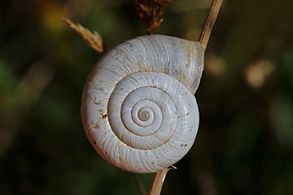Helicella itala
| Helicella itala | |
|---|---|
 | |
| shell of Helicella itala | |
| Scientific classification | |
| Kingdom: | Animalia |
| Phylum: | Mollusca |
| Class: | Gastropoda |
| (unranked): | clade Heterobranchia clade Euthyneura clade Panpulmonata clade Eupulmonata clade Stylommatophora informal group Sigmurethra |
| Superfamily: | Helicoidea |
| Family: | Geomitridae |
| Genus: | Helicella |
| Species: | H. itala |
| Binomial name | |
| Helicella itala (Linnaeus, 1758) | |
| Synonyms | |
| |
Helicella itala is a species of medium-sized, air-breathing land snail, a terrestrial pulmonate gastropod mollusk in the family Geomitridae, the hairy snails and their allies.[1]
The English common name for this species is Heath snail.
- Subspecies
- Helicella itala itala (Linnaeus, 1758)
- Helicella itala pampelonensis (A. Schmidt, 1855)
Life cycle
The width of the egg is 1.5 mm.[2]

This species of snail makes and uses love darts during mating.
Description
The 12–20 mm. shell is broad and very depressed with an open coil forming a convex, low spire. The umbilicus is very wide. The whorls are slightly convex, and have shallow sutures. The aperture is elliptical and lacks an internal rib. The surface (periostracum) is white or pale yellow-brown. The shell often (but not always) has dark brown or yellow-brown spiral bands, and the surface has fine irregular growth ridges.
-
 banded form, apical side
banded form, apical side -
 banded form, umbilical side
banded form, umbilical side -
 white form, apical side
white form, apical side -
 white form, umbilical side
white form, umbilical side
Distribution

The common Heath snail is a West Palearctic species which is found in the British Isles, France, Spain, Belgium, Netherlands, Switzerland, Denmark, Germany, Austria, Czech Republic, and Poland.
Habitat
The animals live on dry, exposed habitats, such as roadsides and railway embankments, vegetated sand dunes as well as rock boulders and short grassland. They live up to 2000 m above sea level in the Alps and Pyrenees.
References
- ^ MolluscaBase eds. (2021). MolluscaBase. Helicella itala (Linnaeus, 1758). Accessed through: World Register of Marine Species at: http://marinespecies.org/aphia.php?p=taxdetails&id=426387 on 2021-02-01
- ^ Heller J.: Life History Strategies. in Barker G. M. (ed.): The biology of terrestrial molluscs. CABI Publishing, Oxon, UK, 2001, ISBN 0-85199-318-4. 1-146, cited page: 428.
- Provoost, S.; Bonte, D. (Ed.) (2004). Animated dunes: a view of biodiversity at the Flemish coast [Levende duinen: een overzicht van de biodiversiteit aan de Vlaamse kust]. Mededelingen van het Instituut voor Natuurbehoud, 22. Instituut voor Natuurbehoud: Brussel, Belgium. ISBN 90-403-0205-7. 416, ill., appendices pp.
External links

- Helicella itala at Animalbase taxonomy, short description, distribution, biology,status (threats), images
- Linnaeus, C. (1758). Systema Naturae per regna tria naturae, secundum classes, ordines, genera, species, cum characteribus, differentiis, synonymis, locis. Editio decima, reformata [10th revised edition], vol. 1: 824 pp. Laurentius Salvius: Holmiae
- v
- t
- e
















